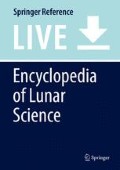References
Anders E, Grevesse N (1988) Abundances of the elements: meteoritic and solar. Geochim Cosmochim Acta 53:197–214
Anders E, Ganapathy R, Keays RR (1971) Volatile and siderophile elements in lunar rocks: comparison with terrestrial and meteoritic basalts. Proc Lunar Sci Conf 2:1021
Chen Y, Zhang Y, Liu Y et al (2015) Water, fluorine, and sulfur concentrations in the lunar mantle. Earth Planet Sci Lett 427:37–46
Dale CW, Burton KW, Greenwood RC et al (2012) Late accretion on the earliest planetesimals revealed by the highly siderophile elements. Science 336:72–75
Day JMD, Walker RJ, James OB, Puchtel IS (2010) Osmium isotope and highly siderophile element systematics of the lunar crust. Earth Planet Sci Lett 289:595–605
Day JMD, Walker RJ (2015) Highly siderophile element depletion in the Moon. Earth Planet Sci Lett 423:114–124
Day JMD, Pearson DG, Taylor LA (2007) Highly siderophile element constraints on accretion and differentiation of the Earth-Moon system. Science 315:217
Delano JW (1986) Abundances of cobalt, nickel, and volatiles in the silicate portion of the Moon. In: Hartmann WK, Philips RJ, Taylor GJ (eds) Origin of the Moon. LPI, Houston, pp 231–248
Drake MJ (1987) Siderophile elements in planetary mantles and the origin of the Moon. J Geophys Res 92:E377–E386
Fischer-Gödde M, Becker H, Wombacher F (2011) Rhodium, gold and other highly siderophile elements in orogenic peridotites and peridotite xenoliths. Chem Geol 270:365–383
Ganapathy R, Keays RR, Laul JC et al (1970) Trace elements in Apollo 11 lunar rocks: Implications for meteorite influx and origin of Moon. In: Proceedings Apollo 11 Lunar Science Conference, Houston. pp 1117–1142
Hauri EH, Saal AE, Rutherford MJ et al (2015) Water in the Moon’s interior: truth and consequences. Earth Planet Sci Lett 409:252–264
Jones JH, Palme H (2000) Geochemical constraints on the origin of the Earth and Moon. In: Canup RM, Righter K (eds) Origin of the Earth and Moon. The University of Arizona Press, Tuscon, pp 197–216
Kruijer TS, Kleine T, Fischer-Gödde M, Sprung P (2015) Lunar tungsten isotopic evidence for the late veneer. Nature 520:534–537
Lodders K (2003) Solar system abundances and condensation temperatures of the elements. Astrophys J 591:1220–1247
McDonough WF, S-s S (1995) The composition of the Earth. Chem Geol 120:223–253
Meyer C (2011) The lunar sample compendium. http://curator.jsc.nasa.gov/Lunar/lsc/index.cfm. Accessed 22 Nov 2015
Newsom HE (1985) Molybdenum in eucrites: evidence for a metal core in the eucrite parent body. J Geophys Res 90:C613–C617
Newsom HE, Beserra TB (1990) Geochemical constraints on the origin of the Moon. Lunar Planet Sci XXI:875–876
Newsom HE, Taylor SE (1989) Geochemical implications of the formation of the Moon by a single giant impact. Nature 338:29–34
O’Neill HSC (1991) The origin of the Moon and the early history of the Earth – a chemical model. Part 1: the Moon. Geochim Cosmochim Acta 55:1135–1157
Rai N, van Westrenen W (2014) Lunar core formation: new constraints from metal-silicate partitioning of siderophile elements. Earth Planet Sci Lett 388:343–352
Righter K (2002) Does the Moon have a metallic core? Constraints from giant impact modeling and siderophile elements. Icarus 158:1–13
Righter K, Drake MJ (1996) Core formation in Earth’s Moon, Mars, and Vesta. Icarus 124:513–529
Righter K, King C, Danielson L et al (2011) Experimental determination of the metal-silicate partition coefficient of Germanium: implications for core and mantle differentiation. Earth Planet Sci Lett 304:379–388
Ringwood AE, Kesson SE (1976) A dynamic model for mare basalt petrogenesis. In: Proceedings of Lunar Science Conference 7th, Houston. pp 1697–1722
Shirey SB, Walker RJ (1998) The Re-Os isotope system in cosmochemistry and high-temperature geochemistry. Annu Rev Earth Planet Sci 26:423–500
Steele AM, Colson RO, Korotev RL et al (1992) Apollo 15 green glass: compositional distribution and petrogenesis. Geochim Cosmochim Acta 56:4075–4090
Steenstra ES, Rai N, Knibbe JS et al (2016a) New geochemical models of core formation in the Moon from metal-silicate partitioning of 15 siderophile elements. Earth Planet Sci Lett 441:1–9
Steenstra ES, Knibbe JS, Rai N, van Westrenen W (2016b) Constraints on core formation in Vesta from metal-silicate partitioning of siderophile elements. Geochim Cosmochim Acta 177:48–61
Steenstra ES, Lin YH, Rai N et al (2016c) Carbon as the dominant light element in the lunar core. Am Mineral doi:10.2138/am-2017-5727
Touboul M, Puchtel IS, Walker RJ (2015) Tungsten isotopic evidence for disproportional late accretion to the Earth and Moon. Nature 520:530–533
Walter MJ, Newsom H, Ertel W et al (2000) Siderophile elements in the Earth and Moon: metal/silicate partitioning and implications for core formation. In: Canup RM, Righter K (eds) Origin of the Earth and Moon. The University of Arizona Press, Tuscon, pp 265–289
Wetzel DT, Hauri EH, Saal AE et al (2015) Carbon content and degassing history of the lunar volcanic glasses. Nat Geosci. doi:10.1038/ngeo2511
Author information
Authors and Affiliations
Corresponding authors
Editor information
Editors and Affiliations
Section Editor information
Rights and permissions
Copyright information
© 2016 Springer International Publishing AG
About this entry
Cite this entry
Steenstra, E.S., van Westrenen, W. (2016). Siderophile Elements in the Lunar Mantle. In: Cudnik, B. (eds) Encyclopedia of Lunar Science. Springer, Cham. https://doi.org/10.1007/978-3-319-05546-6_76-1
Download citation
DOI: https://doi.org/10.1007/978-3-319-05546-6_76-1
Received:
Accepted:
Published:
Publisher Name: Springer, Cham
Online ISBN: 978-3-319-05546-6
eBook Packages: Springer Reference Physics and AstronomyReference Module Physical and Materials ScienceReference Module Chemistry, Materials and Physics

